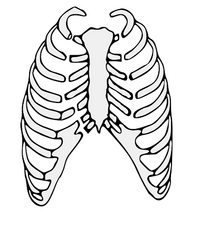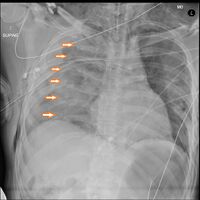Rib fractures
Rib fractures are caused either by indirect violence (traffic accidents, crush-syndrome), which affects the entire chest and leads to fractures in an axis perpendicular to the application of pressure, or by direct violence to a certain area and fractures in her (hits with an object, falls, sports injuries).
We can distinguish multiple fractures that occur on one rib (segmental fractures) or fractures that affect several ribs above each other (serial fractures).
The most serious type is the so-called door fracture, when several ribs are broken on both sides, creating a "door" in the chest wall. The broken part subsequently causes the phenomenon of paradoxical breathing - when exhaling, it rises and when inhaling, it falls. This arching and sag is visible as the chest wall moves. It is related to the changing pressure in the interpleural space.
Diagnosis of rib fractures[edit | edit source]
A patient with rib fractures has significant pain, which can be detected by simply compressing the chest during the admission examination. The patient will show us the exact location of the fracture himself. The same localized painis also caused by deep inhalation or exhalation. That's why thebreathing is very superficial in the afflicted. Typical is bradypnea with pain, sometimes irritating cough and cyanosis. Rib fractures are recognizable on the native X-ray chest image. In unclear cases, a CT examination can help. On the X-ray image, we can also diagnose pneumothorax (collapsing of the lung to the hilum, possibly a deformed lung shadow due to fusion of the pleura with the surroundings) and hemothorax in the presence of more than 250 ml of fluid (shadowing in the area of the costophrenic angles). If pneumohemothorax occurs at the same time, air-fluid level is visible at the gas-liquid boundary.
Treatment of rib fractures[edit | edit source]
The treatment of rib fractures is mainly conservative. Mostly in the form of a bandage or other fixation of the chest. It is recommended to position the patient in a semi-sitting position (Fowler's position), which facilitates breathing. Rib fractures are very painful, which is why analgesic treatment (opiates, Codeine) or local injection of the intercostal nerves is recommended (local anesthesia). In case of significant cyanosis of the patient or fracture of more than 5 ribs, we proceed to artificial pulmonary ventilation. Operative solution using small splints is only chosen for unstable chests. Rib fractures take approximately 3-6 weeks to heal. On X-ray images, we can see thickening in the area of the original fracture, which is an image of the forming muscle. During recovery, breathing exercises are recommended after being instructed by rehabilitation workers.
Complications of rib fractures[edit | edit source]
Lung injury and pneumothorax or hemothorax often occur. When the so-called splenic ribs (9th-11th rib on the left) are injured, the spleen is often injured with the risk of hemoperitoneum.
Links[edit | edit source]
Related articles[edit | edit source]
Source[edit | edit source]
Literature[edit | edit source]
- ZEMAN, Miroslav, et al. Speciální chirurgie. 2. edition. Praha : Galén, 2006. 575 pp. ISBN 80-7262-260-9.




